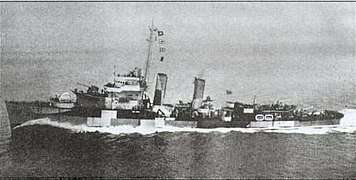Marcílio Dias-class destroyer
 Greenhalgh | |
| Class overview | |
|---|---|
| Name: | Marcílio Dias class |
| Builders: | Ilha das Cobras, Rio de Janeiro |
| Operators: |
|
| Preceded by: |
Jurua class (planned) Maranhão (actual) |
| Succeeded by: | Acre class |
| Completed: | 3 |
| Retired: | 3 |
| General characteristics as designed | |
| Type: | Destroyer |
| Displacement: |
|
| Length: | |
| Beam: | 10.61 m (34 ft 10 in) |
| Draught: | 3.04 m (10 ft 0 in) mean |
| Propulsion: | 2-shaft General Electric Company geared turbines |
| Speed: | 36.5 knots (67.6 km/h; 42.0 mph) |
| Range: | 6,500 nmi (12,038 km; 7,480 mi) at 15 knots (28 km/h; 17 mph) |
| Endurance: | 559 t (550 long tons) fuel oil |
| Complement: | 190 |
| Armament: |
|
The Marcílio Dias-class destroyers (sometimes referred to as M class) were three destroyers of the Brazilian Navy that served during World War II. They were based on the United States Navy's Mahan class. The Marcílio Dias class were the first warships to be constructed in Brazil of any type. They entered service in 1943 and served on Atlantic convoy duty with the Allies. In July 1944, the three destroyers escorted the Brazilian Expeditionary Force to Italy. Following the end of the war, the destroyers remained in service, undergoing modernisation. Two were discarded in 1966, with the last taken out of service in 1973.
Design and description
After joining the Allies in World War II on 22 August 1942, Brazil began to receive support from the United States. After the previous planned class of destroyers for the Brazilian Navy had been acquired by the British Royal Navy in 1939, the Brazilian Navy sought to replace them. With United States' support, the Brazilian Navy acquired the plans of the Mahan class and set about making essentially a copied design to be built in Brazil. The Marcílio Dias class had a standard displacement of 1,524 tonnes (1,500 long tons) and were 2,235 t (2,200 long tons) at full load. They were 108.81 metres (357 ft 0 in) long overall and 103.94 metres (341 ft 0 in) between perpendiculars with a beam of 10.61 metres (34 ft 10 in) and a mean draught of 3.04 m (10 ft 0 in).[1][2]
The destroyers were powered by four Babcock & Wilcox Express boilers supplying steam to General Electric Company geared turbines that drove two shafts. The engines were rated at 42,800 shaft horsepower (31,916 kW) and the vessels had a maximum speed of 36.5 knots (67.6 km/h; 42.0 mph). The Marcílio Dias class had capacity for 559 tonnes (550 long tons) of fuel oil and had a range of 6,500 nautical miles (12,038 km; 7,480 mi) at 15 knots (28 km/h; 17 mph). The destroyers had a complement of 190 officers and ratings.[1][2]
The planned armament of the class was to be five 5-inch (127 mm)/38 calibre guns mounted in single turrets. This was augmented with four 40 mm guns and four 20 mm guns for anti-aircraft defence. They were also to be equipped with two quadruple 21-inch (533 mm) torpedo tube mounts.[1][2] However, while under construction, one of the 5-inch guns and one of the quad mounts of torpedo tubes were removed and the number of 20 mm guns was increased to eight. Only the forward 5-inch gun was given a gun shield. For anti-submarine warfare, the destroyers were given two depth charge racks, four depth charge throwers and equipped with sonar.[3]
In 1966 a Sea Cat missile system was fitted to Mariz e Barros, with the destroyer used as a test platform. The system was later removed and installed on the Allen M. Sumner-class destroyer Mato Grosso.[4]
Ships of the class
| Marcílio Dias-class destroyers[1] | ||||||
| Ship | Pennant number | Builder | Laid down | Launched | Commissioned | Fate |
|---|---|---|---|---|---|---|
| Marcílio Dias | M1 | Ilha das Cobras, Rio de Janeiro | 8 May 1937 | 20 July 1940 | 29 November 1943 | Stricken 1966 |
| Mariz e Barros | M2 | 1937 | 28 December 1940 | Stricken 1972 | ||
| Greenhalgh | M3 | 1937 | 8 July 1941 | Stricken 1966 | ||
Service history
The Marcílio Dias were the first warships constructed in Brazil of any size, and due to this fact, took a long time to build.[1][5] After commissioning, all three vessels were assigned to Naval Forces North-East patrolling the South Atlantic. Each patrol lasted roughly fourteen days and were used primarily to intercept Axis blockade runners. The patrols sometimes worked in concert with United States Navy forces. The destroyers also saw convoy escort duty between Rio de Janeiro, Recife and Trinidad and in July 1944, escorted the five convoys that carried the Brazilian Expeditionary Force to Italy.[3]
Citations
- 1 2 3 4 5 Whitley 2000, p. 21.
- 1 2 3 Chesneau 1980, p. 417.
- 1 2 Whitley 2000, p. 22.
- ↑ Gardiner, Chumbley & Budzbon 1995, p. 29.
- ↑ Chesneau 1980, p. 416.
Sources
- Chesneau, Roger, ed. (1980). Conway's All the World's Fighting Ships 1922–1946. Greenwich, UK: Conway Maritime Press. ISBN 0-85177-146-7.
- Gardiner, Robert; Chumbley, Stephen & Budzbon, Przemysław, eds. (1995). Conway's All the World's Fighting Ships 1947–1995. Annapolis, Maryland: Naval Institute Press. ISBN 1-55750-132-7.
- Whitley, M. J. (2000) [1988]. Destroyers of World War Two: An International Encyclopedia. Annapolis, Maryland: Naval Institute Press. ISBN 0-87021-326-1.